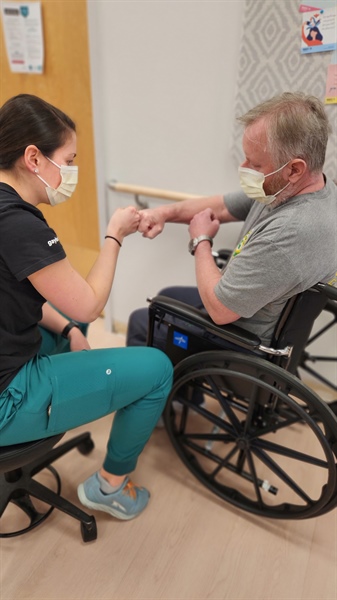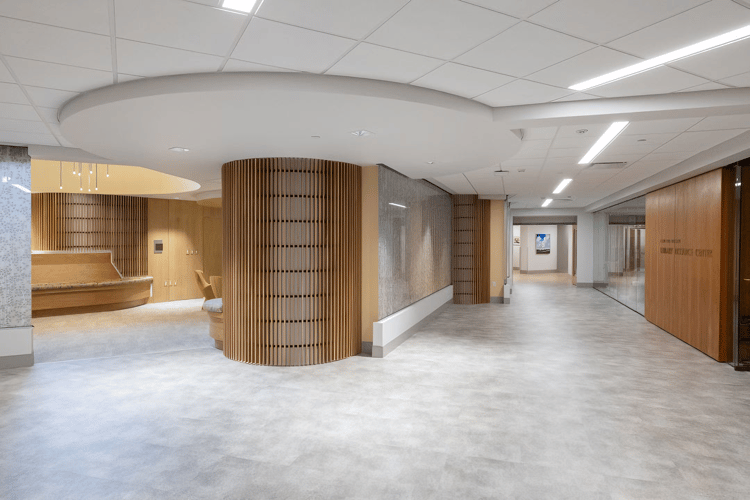
Mary Turner had just gotten off the phone when an unusual movement in the next room caught her eye.
She looked up to see her 60-year-old husband Paul, a recently retired Hamden firefighter and a 21-year Air Force veteran, stagger and grab the back of a couch to steady himself.
“I asked what was going on, but there was no answer,” Mary recalled.
Mary ran to Paul as he suddenly clutched his left arm and moved it across his chest.
“I couldn’t imagine what he was doing until I saw that his mouth was drooping a little. I immediately knew he was having a stroke.”
Within minutes, Paul was surrounded by Hamden emergency personnel, all long-time friends and “family” from his decades of service as a first responder.
At Yale New Haven Hospital, Paul underwent a thrombectomy to remove clots from his brain. During the delicate process, a piece of clot broke off, a common risk in such procedures.
“Essentially, we were able to trade the massive, life-threatening stroke he was having for a milder, still-severe stroke,” said Mary. “And even though we knew he might have some cognitive and physical impairments to overcome, there was hope.”
Paul was still in the Neuro ICU when doctors suggested that playing sing-along music might encourage his verbal fluency. Determined to give the idea a shot, Mary began playing classic Disney songs on her cell phone.
A few songs in when The Lion King’s ‘Hakuna Matata’ began to play, Paul began to repeat the words ‘Hakuna Matata,’ a phrase that aptly means ‘no worries.’
“That’s when I knew everything would be okay,” Mary explained.
When it came time to discuss the next steps in Paul’s long-term rehabilitation, Mary insisted on Gaylord Hospital, a hospital that had worked “miracles” for several of their friends and family members.
Sixteen days after his stroke, Paul arrived at Gaylord unable to walk and with limited speech. Despite his medically fragile condition, his therapists wasted no time performing therapy at the bedside to kick-start his recovery.
For weeks, Paul had very little movement on his left side until a “miracle” on Thanksgiving Day left his family counting their blessings.
“My left leg moved … with meaning,” Paul recalled. “That was my epiphany.”
Paul worked hard to regain the use of his left arm and leg while also overcoming visual deficits on his left-side and soon began to use a walker.
“The therapy and schedule were perfect,” Mary recalled.
“His therapists knew when to push and when to pull back. They gave us homework to work on in the room. Soon, he was ready to move to the next step of his recovery. That’s when we learned about Traurig House.”
Paul was deemed an excellent candidate for Gaylord’s Traurig House, Connecticut’s only transitional living center for people recovering from brain injury or stroke.
Although Paul was eager to return to his family, he and Mary agreed that Traurig House was an exceptional opportunity to regain the communication, cognitive, and life skills he needed to return home.
“It was one of the best decisions we have ever made as a couple,” Mary affirmed.
Throughout his three-month Traurig residency, Paul continued a rigorous regimen of outpatient therapies five days a week and spent his weekends at home with family.
“The first few weekends at home were hard, but it helped us to discover the logistical shortfalls that we would never have thought of … like his wheelchair that was just a few centimeters too wide for our doorways. Traurig House let us trial a narrower chair, and it was a game-changer,” Mary explained.
Now at home, Paul continues to come to Gaylord three times a week for outpatient physical, occupational, speech, and aquatic therapies. He also attends Exercise for Life, a free high-intensity exercise class for people with disabilities at Gaylord Physical Therapy in Cheshire.
“After months of being at Gaylord, there’s not one thing I can say that they should change,” Mary said. “Everyone we encountered is a little miracle worker.”
Today, Mary and Paul are preparing to take their first vacation since his stroke nearly one year ago. It’s an adventure, Mary says, that would have been “completely out of the realm of possibility” only a few months ago.
“Paul has made such incredible gains … and it’s all thanks to Gaylord. Gaylord and Traurig absolutely gave Paul’s life back to him. They taught him how to work within his means. Our whole experience has been nothing but a whirlwind of miracles!”
